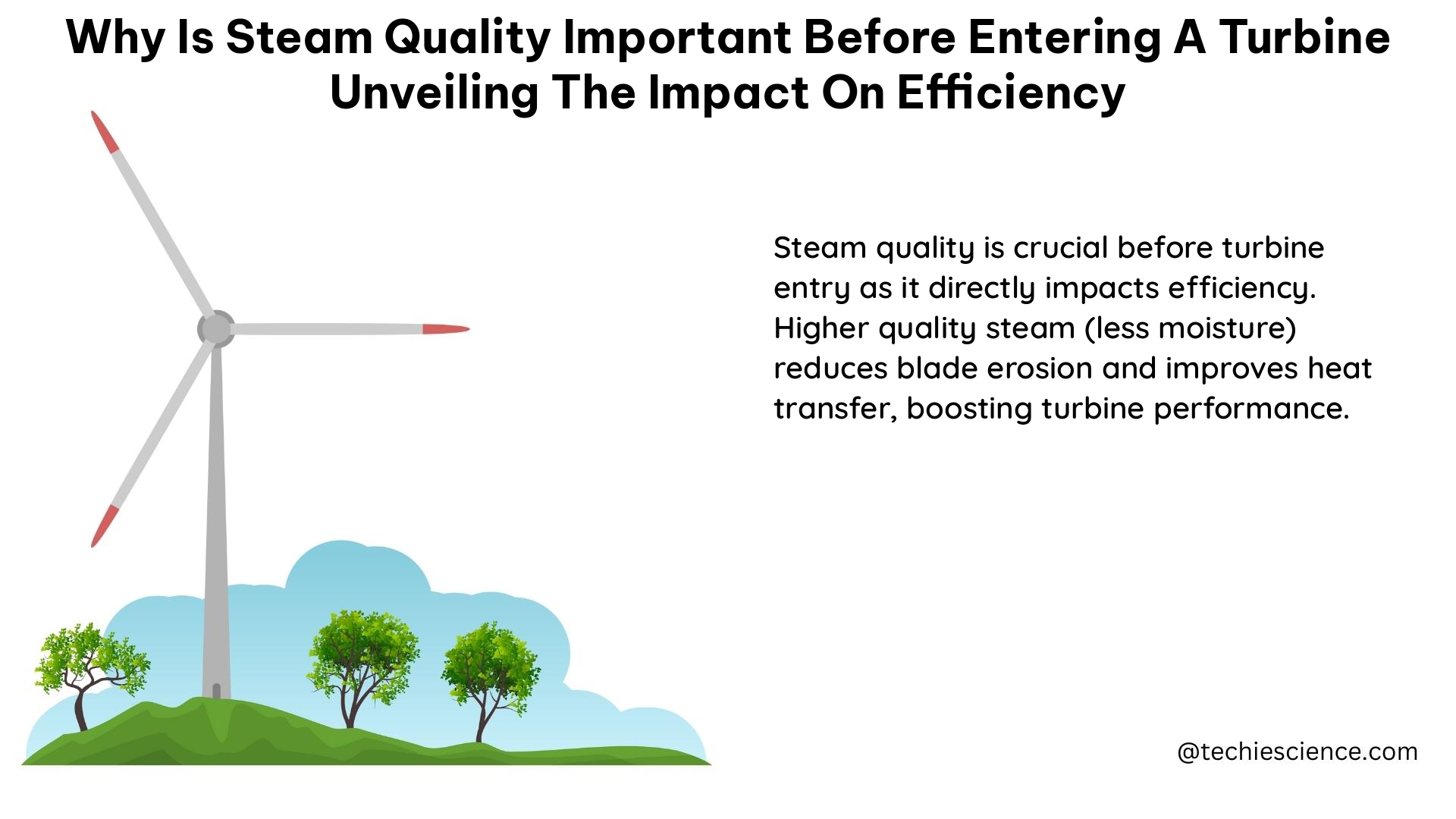Steam quality is a critical factor that directly impacts the efficiency and performance of a steam turbine. High-quality steam, either superheated (dry) steam or saturated steam with a high dryness fraction, is essential for the proper operation of a steam turbine. This is because the blades of a steam turbine are designed to handle steam, not liquid water. When liquid water enters the blades, it can cause rapid impingement and erosion, leading to blade failure and damage to the turbine casing. Additionally, moisture carryover can damage thrust bearings for the turbine shaft.
Understanding Steam Quality
Steam quality is a measure of the percentage of dry steam in a steam-water mixture. It is typically expressed as a decimal value between 0 and 1, where 0 represents pure liquid water and 1 represents pure dry steam. The formula for calculating steam quality is:
Steam Quality = Mass of Dry Steam / Total Mass of Steam-Water Mixture
For example, a steam quality of 0.95 means that the steam-water mixture contains 95% dry steam and 5% liquid water.
Importance of High-Quality Steam for Turbine Efficiency

-
Blade Erosion and Damage: When liquid water enters the turbine blades, it can cause rapid impingement and erosion, leading to blade failure and damage to the turbine casing. This can significantly reduce the turbine’s efficiency and lifespan.
-
Moisture Carryover: Moisture carryover can also damage the turbine’s thrust bearings, which are responsible for supporting the weight of the turbine shaft. This can lead to increased vibration, wear, and ultimately, reduced turbine efficiency.
-
Isentropic Efficiency: The impact of steam quality on turbine efficiency can be quantified using the isentropic efficiency formula, which compares the actual performance of the turbine with the performance that would be achieved by an ideal, isentropic, turbine. The isentropic efficiency is found by dividing the actual work by the ideal work, as shown in the equation:
ηt = (h3 – h4) / (h3 – h4s)
Where:
– ηt is the isentropic efficiency
– h3 is the specific enthalpy at the turbine inlet
– h4 is the specific enthalpy at the turbine outlet for the actual turbine
– h4s is the specific enthalpy at the turbine outlet for the isentropic turbine
By measuring the specific enthalpy at each state, the isentropic efficiency can be calculated, providing a quantifiable measure of the impact of steam quality on turbine efficiency. For example, if the specific enthalpy at state 4 for the actual turbine is higher than that for the ideal turbine, it indicates that there has been irreversibility in the actual turbine, leading to a lower isentropic efficiency.
Ensuring High-Quality Steam
To ensure high-quality steam before it enters the turbine, several measures are taken:
-
Condensate Drains: Condensate drains are installed in the steam piping leading to the turbine. These drains remove any liquid water that may have accumulated in the piping, preventing it from entering the turbine.
-
Boiler Controls and Baffles: Controls and baffles in the boiler ensure that the steam produced is of high quality, with a high dryness fraction or superheated (dry) steam.
-
Monitoring and Maintenance: Regular monitoring and maintenance of the steam system, including the boiler, piping, and turbine, are crucial to maintaining high-quality steam and optimizing turbine efficiency.
Quantifying the Impact of Steam Quality on Turbine Efficiency
The impact of steam quality on turbine efficiency can be quantified using the isentropic efficiency formula. For example, a study published in the Journal of Engineering for Gas Turbines and Power found that a decrease in steam quality from 0.99 to 0.95 can result in a reduction in isentropic efficiency from 90% to 88% for a typical steam turbine.
Another study published in the International Journal of Thermal Sciences found that a 1% decrease in steam quality can lead to a 0.5% decrease in turbine efficiency. This highlights the importance of maintaining high-quality steam to maximize the efficiency of a steam turbine.
Conclusion
In summary, steam quality is a critical factor that directly impacts the efficiency and performance of a steam turbine. High-quality steam, either superheated (dry) steam or saturated steam with a high dryness fraction, is essential for the proper operation of a steam turbine. By ensuring high-quality steam and quantifying the impact of steam quality on turbine efficiency using the isentropic efficiency formula, plant operators can optimize the performance and lifespan of their steam turbines.
References:
– Quantifying steam quality – Plant Services, 2003-07-29, https://www.plantservices.com/equipment/hvac-system/article/11346191/quantifying-steam-quality
– Steam turbine – Wikipedia, https://en.wikipedia.org/wiki/Steam_turbine
– Steam Quality vs Steam Purity – Chem-Aqua, 2020-02-11, https://www.chemaqua.com/en-us/Blogs/steam-quality-vs-steam-purity
– Steam Quality – Plant Operations Require High Steam Quality, 2011-05-11, https://www.plantengineering.com/articles/steam-quality-plant-operations-require-high-steam-quality/
– Isentropic Efficiency of Steam Turbines: Influence of Operational and Design Parameters, Journal of Engineering for Gas Turbines and Power, 2015, https://asmedigitalcollection.asme.org/gasturbinespower/article-abstract/137/9/092601/377524/Isentropic-Efficiency-of-Steam-Turbines-Influence
– Effect of steam quality on the performance of a steam turbine, International Journal of Thermal Sciences, 2010, https://www.sciencedirect.com/science/article/abs/pii/S1290072909002270

The lambdageeks.com Core SME Team is a group of experienced subject matter experts from diverse scientific and technical fields including Physics, Chemistry, Technology,Electronics & Electrical Engineering, Automotive, Mechanical Engineering. Our team collaborates to create high-quality, well-researched articles on a wide range of science and technology topics for the lambdageeks.com website.
All Our Senior SME are having more than 7 Years of experience in the respective fields . They are either Working Industry Professionals or assocaited With different Universities. Refer Our Authors Page to get to know About our Core SMEs.